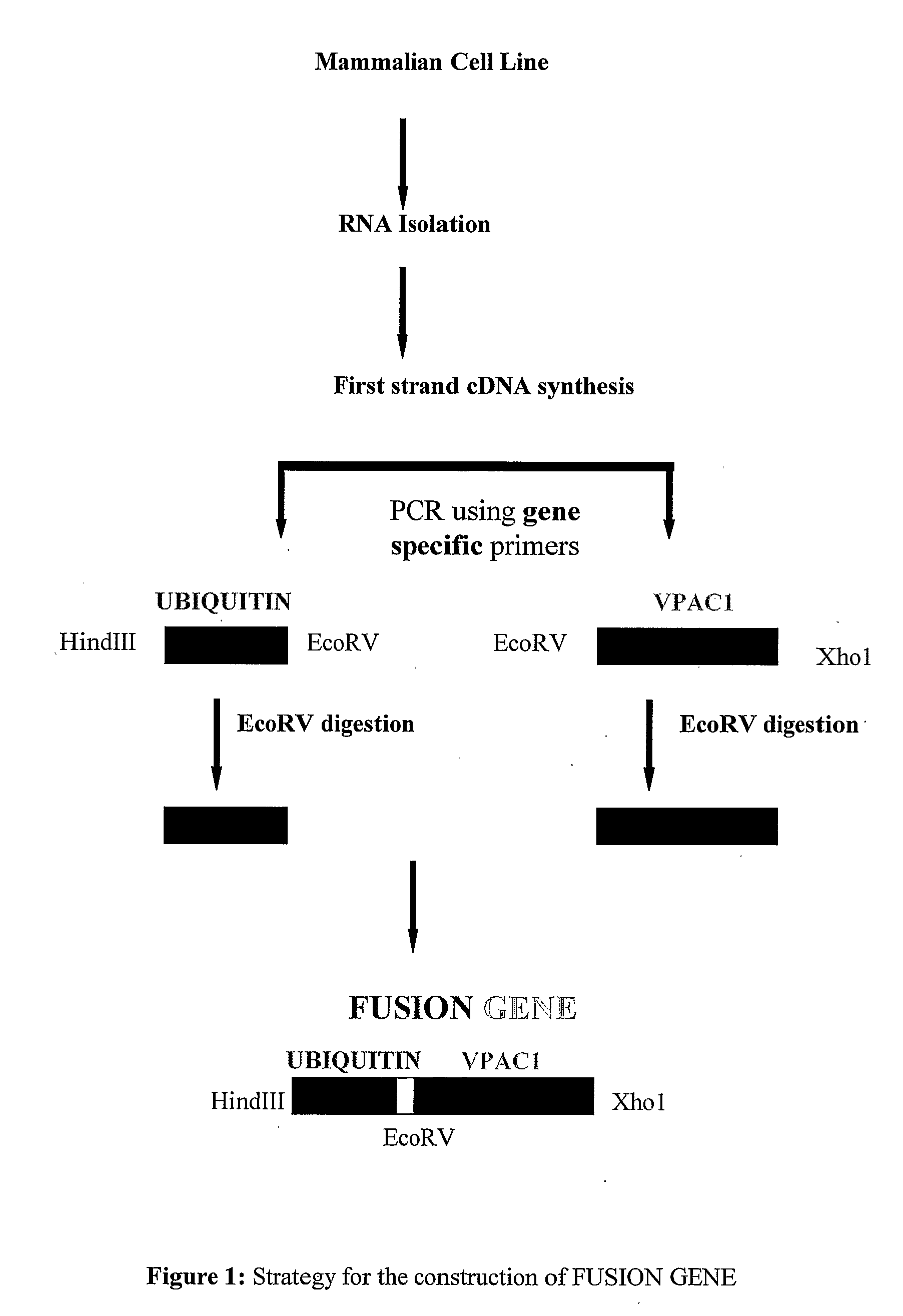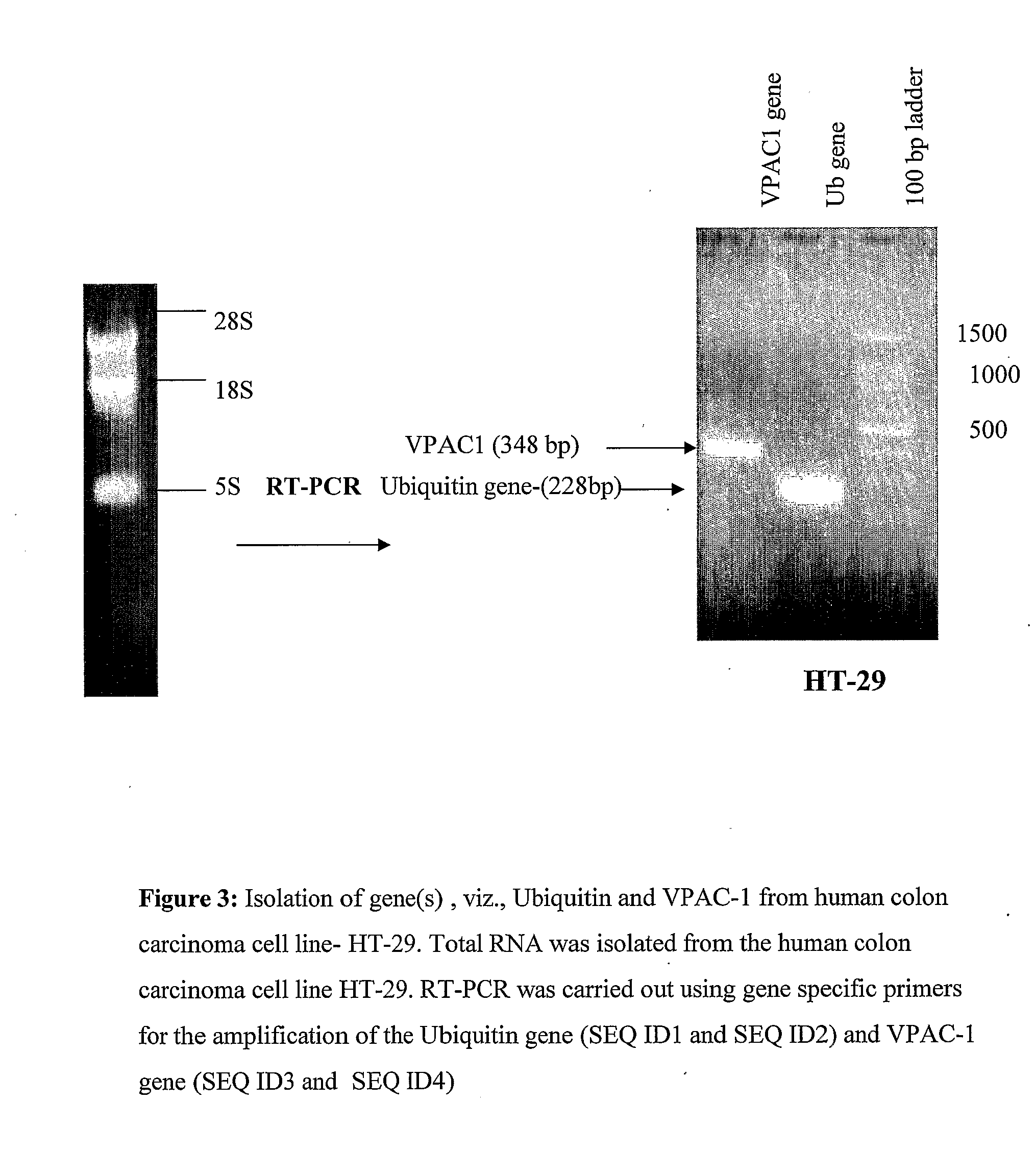DNA Vaccine for Cancer Therapy
a cancer and dna technology, applied in the field of synthetic fusion genes, can solve the problems of peptide vaccines being able to raise irrelevant peptide-specific responses, tumor antigens cannot be recognized by cells, carbohydrate vaccines are the possibility of raising an irrelevant peptide-specific response, etc., to achieve marked suppression of tumor growth, enhance the potential clinical effect, and confirm the therapeutic and prophylactic potential
- Summary
- Abstract
- Description
- Claims
- Application Information
AI Technical Summary
Benefits of technology
Problems solved by technology
Method used
Image
Examples
example 1
Construction of Fusion Gene
[0100]A cDNA encoding for human Ub and VPAC1 gene was obtained by reverse transcriptase polymerase chain reaction (RT-PCR), using RNA isolated from HT-29 cells specific primers for Ub (SEQ ID 1 and SEQ ID 2) and VPAC1 (SEQ ID 3 and SEQ ID 4) were used to amplify the genes selectively from cDNA of HT29 colon cancer cells. The reaction condition of the PCR was; 97° C. for 3 min, followed by thirty cycles of 95° C. at 1 min, 60° C. for 2 min, 72° for 30 sec. After this a final step of elongation at 72° C. for 7 min was followed by cooling at 4° C.
[0101]Plasmid containing human VPAC1 was constructed as: VPAC1 cDNA was amplified by PCR using sense (SEQ ID 5) and antisense (SEQ ID 4) primers. PCR product of VPAC1 cDNA was inserted into HindIII and Xho1 site of pcDNA3.1HisA vector (Invitrogen, San Diego, Calif., USA). The resulting plasmid, designated pVPAC1, contained the human VPAC1 coding sequence.
[0102]A plasmid for the expression of Ub fused VPAC1 (extra cel...
example 2
Expression of the Fusion Gene
[0103]The expression of the genes (Ub-VPAC1 and VPAC1) was confirmed by RT-PCR. Transfection was carried out using commercially available Lipofectamine reagent (Invitrogen). Transfection was carried out in murine melanoma B16F10 cells. B16F10 cells were plated in six well plates at 90% confluency in DMEM media without antibiotics. 4 μg of plasmid DNA of each construct, viz. pcDNA; pVPAC1 and pUb-VPAC1 was diluted in 250 uL of DMEM media without serum and antibiotics. 10 μl of Lipofectamine™ 2000 reagent (Invitrogen) was also diluted in a similar way. After 5 minutes of incubation at room temperature, diluted DNA and lipofectamine were mixed together to form a complex. After 20 minutes of incubation at room temperature the complex was added to the cells in 2 ml of DMEM media without sera and antibiotics. Plate was incubated inside the CO2 incubator for 6 hours and then media was replaced with complete DMEM media. 24 hours post-transfection, 1 ml of Trizol...
example 3
CTL Activity
[0105]To investigate the tumor cytotoxicity of the constructs, female C57BL / 6J black mice (6-8 week old) were immunized on hind limbs by intramuscular injections of plasmid constructs (pUb-VPAC1, pVPAC1, and vector alone). For each type of plasmid, 3 mice were used in each treatment group. The mice were immunized 3 times, at 14-days intervals, with 100 μg of plasmid DNA. 2-weeks after the final immunization, mice were euthanized. Spleen was isolated. The spleen cells were washed extensively with RPMI media. The cells were further treated with 0.1M ammonium chloride solutions for the lysis of RBCs. The cells were washed with the RPMI media, counted using a haemocytometer and used further as effector cells. The target cell line, B16F10 was plated on 96-well plate at a density of 7500 cells / well. After 2 hours, the effector cells were added and the co-cultures were incubated for another 4 hr. The effector to target ratio (E: T) was taken at 50:1, 25:1, 12.5:1 and 6.25:1. Pr...
PUM
| Property | Measurement | Unit |
|---|---|---|
| Polarity | aaaaa | aaaaa |
| Acidity | aaaaa | aaaaa |
| Degradation properties | aaaaa | aaaaa |
Abstract
Description
Claims
Application Information
 Login to View More
Login to View More - R&D
- Intellectual Property
- Life Sciences
- Materials
- Tech Scout
- Unparalleled Data Quality
- Higher Quality Content
- 60% Fewer Hallucinations
Browse by: Latest US Patents, China's latest patents, Technical Efficacy Thesaurus, Application Domain, Technology Topic, Popular Technical Reports.
© 2025 PatSnap. All rights reserved.Legal|Privacy policy|Modern Slavery Act Transparency Statement|Sitemap|About US| Contact US: help@patsnap.com



